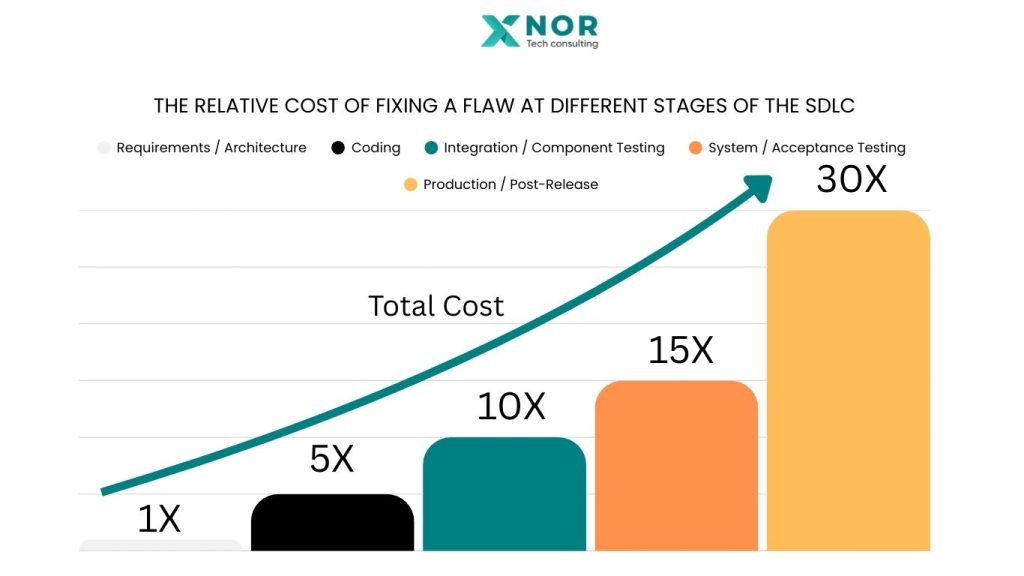Skipping software QA might save time in the short term – but the long-term cost? Buggy products, lost users, and brand damage. Discover how quality control and testing protect your software – and your business.
Imagine this scenario: Your software just launched. The marketing hype is paying off, user traffic spikes, and conversion begins to roll in. But then – error messages. Slowdowns. Crashes. Your support inbox is drowning, app store reviews are tanking, and your team is now firefighting bugs you didn’t anticipate.
This isn’t bad luck – it’s the cost of skipping software quality assurance (QA). QA is not a “nice-to-have”; it’s the difference between delighting your users and destroying their trust.

What Is Software Quality Assurance and What Isn’t It?
Software quality assurance (SQA) is a comprehensive process that ensures your software meets the required quality benchmarks across the development lifecycle. Unlike software testing alone, SQA spans requirements, design, coding, testing, release, and maintenance.
Here’s what it includes:
- Requirement validation
- Test planning and execution
- Bug tracking and resolution
- Code reviews and process audits
- Risk analysis and compliance checks
Software Quality Assurance vs Testing: What’s the Real Difference?
| Software Testing | Quality Assurance (QA) | |
| Goal | Find bugs | Prevent bugs and improve processes |
| When | After development | Throughout development |
| Responsibility | Testers only | QA team, developers, managers |
| Scope | Feature-focused | Process + product-oriented |
The Real-World Impact of Poor QA
When software fails, the consequences ripple throughout an organization:
1. Financial hemorrhage
Bugs found post-launch can cost up to 30x more to fix than if caught during development (IBM Systems Sciences Institute).
2. Customer exodus
A staggering 88% of users are less likely to return after a bad user experience. Poor quality assurance = poor retention.
3. Security breaches
Lack of QA means missed vulnerabilities – prime targets for data breaches and cyberattacks.
4. Regulatory penalties
Quality management plays a key role in ensuring compliance (GDPR, HIPAA, PCI-DSS). Skipping it can mean lawsuits and fines.

Meet Your Software’s Frontline Hero: The QA Tester
A QA tester doesn’t just “check for bugs.” They simulate real-world usage, anticipate edge cases, and ensure the product behaves consistently across environments.
What QA testers actually do:
- Create manual and automated test cases
- Execute tests across browsers, devices, and networks
- Log and track bugs using platforms like Jira
- Collaborate with developers on resolution strategies
- Ensure compliance with UX and accessibility standards
6 Game-Changing Benefits of Software Quality Assurance
1. Prevent Catastrophic Bugs
Catch issues before they hit your users.
2. Improve Performance & Scalability
Testing process ensures your product handles high traffic without breaking.
3. Enhance User Experience
Clean interfaces and smooth interactions build trust.
4. Reduce Time-to-Market
QA may seem like a delay, but it prevents costly rework later.
5. Protect Your Reputation
Reliable software = strong brand perception.
6. Ensure Compliance
From HIPAA to GDPR, QA ensures legal readiness.
Where QA Fits in the Software Development Lifecycle

Effective quality assurance isn’t a single phase, but a continuous process integrated throughout development:
Requirements Phase
Early QA involvement helps clarify requirements and establish testable criteria before development begins.
Development Phase
Continuous testing during development catches issues when they’re easiest and least expensive to fix.
Pre-Release Phase
Comprehensive validation ensures the software meets all quality standards before reaching users.
Post-Deployment Phase
Ongoing monitoring and testing help maintain quality as the software evolves to meet changing needs.
Selecting the Right QA Partner
When choosing a quality assurance partner, consider:
- Technical alignment with your development stack and methodologies
- Industry experience with similar applications and domain knowledge
- Testing infrastructure including automation capabilities and testing environments
- Communication processes for clear, actionable bug reporting
- Scalability to adapt to changing project requirements
Tools We Use to Deliver Precision QA
| Tool | Purpose |
| Jira | Bug tracking and task management |
| TestRail | Test case management |
| Postman | API testing |
| Selenium | Automated UI testing |
| BrowserStack | Cross-platform device/browser testing |
Why Outsourcing QA Might Be Your Smartest Move
Outsourcing QA isn’t just about saving costs – it’s about expanding capabilities and accelerating outcomes.
Benefits of outsource QA:
Access to Diverse Testing Environments
Effective QA requires testing across numerous:
- Device types (desktops, tablets, smartphones)
- Operating systems and versions
- Browsers and browser versions
- Network conditions and connectivity scenarios
Maintaining this diverse testing infrastructure internally is both expensive and logistically challenging. Outsourced QA partners already have these environments established, allowing for immediate comprehensive testing without additional investment.
Flexible Scaling
Software development rarely follows a predictable, steady pace. Project demands fluctuate based on:
- Release cycles and deadlines
- Feature complexity
- Changing requirements
- Market pressures
Outsourced QA allows you to scale testing resources up or down according to these changing needs without the overhead of hiring, training, or reassigning internal staff.
Focus on Core Competencies
For most organizations, software development supports business objectives, but quality assurance isn’t a core competency. Outsourcing QA allows your team to:
- Concentrate on building new features
- Focus on innovation rather than validation
- Accelerate development cycles
- Reduce management overhead
Fresh Perspective Advantage
Internal teams can develop “tunnel vision” after working with the same codebase for extended periods. Outsourced QA specialists bring:
- Unbiased viewpoints
- Experience from diverse projects
- Novel testing approaches
- Industry best practices
This fresh perspective often uncovers issues that might otherwise go undetected until they reach your customers.
Why XNOR? A Trusted QA Testing Company

At XNOR, we understand that quality isn’t just technical – it’s strategic.
Comprehensive Testing Methodology
- Functional testing – Ensures features work as expected
- Regression testing – Prevents new updates from breaking old features
- Automated testing – Scales testing speed and consistency
- Manual testing – Captures edge cases automation may miss
- Security testing – Identifies exploitable vulnerabilities
- Performance testing – Validates speed, load, and stress handling
Industry-Specific Expertise
XNOR’s testing teams specialize in various sectors, bringing domain knowledge that generic QA services simply can’t match. This expertise extends across:
- Financial services and banking applications
- Healthcare and medical software
- E-commerce platforms
- Enterprise resource planning (ERP) systems
- Mobile applications for various industries
- IoT and embedded software systems
Transparent Partnership Approach
We integrate directly with your team using tools like Jira, Slack, and Confluence – delivering real-time visibility.
Proven Track Record
XNOR’s success stories speak volumes about our capabilities:
- Exceptional client retention with long-term partnerships spanning years
- Significant reduction in post-release defects for all client projects
- Substantial cost savings compared to maintaining in-house testing teams
- Consistent on-time delivery of comprehensive test results
- Glowing testimonials from clients across various industries
“We don’t just test software—we test experiences.”
Let our QA experts turn your software into a product users can trust and love.
Final Thoughts: QA Is the Insurance Policy Your Product Needs
Skipping QA is like launching a rocket with loose screws. It might fly… but when it crashes, the fallout will be severe.
QA isn’t an optional stage—it’s a competitive differentiator. It’s how you ensure your software is usable, scalable, secure, and lovable.
Don’t let hidden bugs kill your momentum. Don’t wait for customers to find your flaws. Invest in QA early—and reap the rewards long-term.



